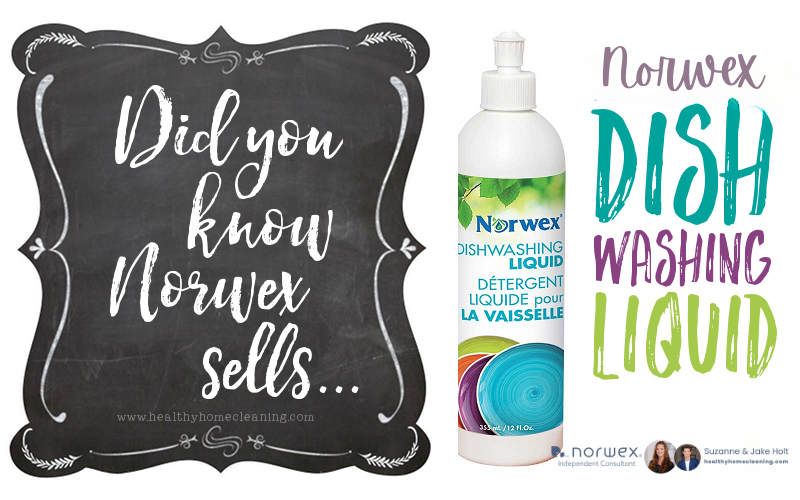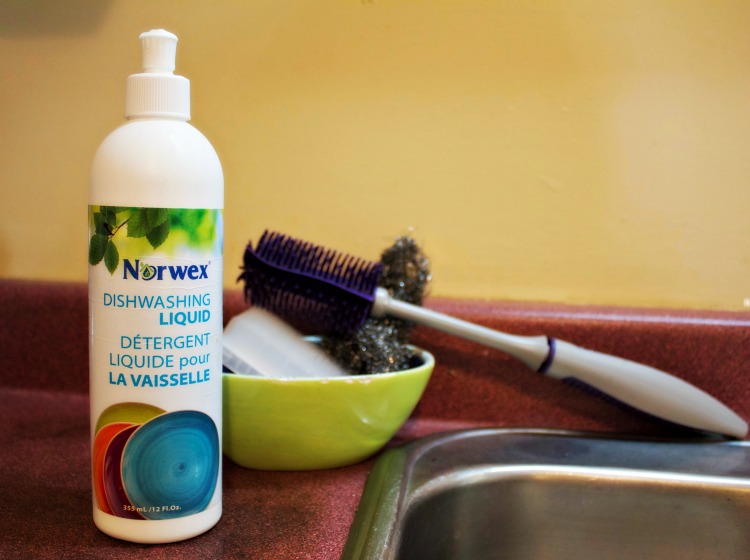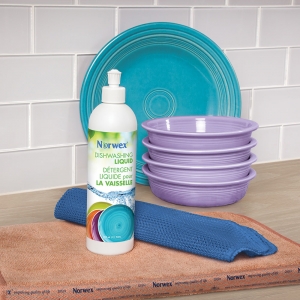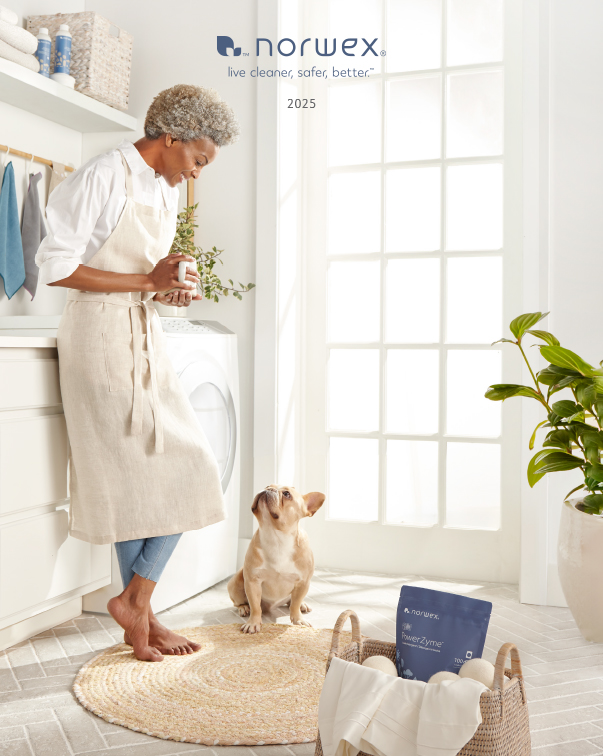
Want to learn more about a green dish soap from Norwex? Today’s article features the Norwex Dish Soap, aka Dishwashing liquid, as part of an ongoing series that helps you discover the hidden gems that you may have missed at your first look through of our catalog! Norwex has SO many products in their catalog. In fact, with over 80 items, I bet there’s a lot that you’ve missed that will surprise you! One of the common statements I hear from people is, “What?! Norwex sells that!?”
You can see previous posts in this series, like “Did You Know Norwex Sells Deodorant?” and “Did You Know Norwex Sells Reusable Grocery Bags?”
Norwex Green Dish Soap
So, you can buy dish soap everywhere and anywhere. For super cheap, too. So the question is: why does Norwex make dish soap? And, why would you want to invest in it, since other dish soaps are, quite frankly, cheaper!
The Awesome Benefits of This Green Dish Soap
- Biodegradable, and free from phthalates, SLS, SLES and dyes.
- 100% natural
- Suitable for septic tanks
- Super concentrated, so you only need one tablespoon for a full sink
- Bottle is recyclable
- It smells Gooooooood. It has a crisp, citrus aroma. And because the fragrance is natural, it’s not the gross orange-cleaner smell!
The Science Behind the Awesomeness
Put on your science-geek glasses for this read, you’re gonna be super smart about ingredients after this one! While writing this article, I did deeper digging than I had ever done regarding the ingredients in this product, and was SUPER impressed!
Ingredients:
Glycerin, Laurel Glucoside, Sodium Laurel Sulfoacetate, Cocoamidopropyl Betaine, Sodium Citrate, Clementine Essential oil, Chloro-2-methyl-4isothiazolin-3-one, Methyl-4-isothiazolin-3-one
So, I know that you don’t know how to pronounce some of the words in the ingredient list. Let me give you a few cool facts about these ingredients.
Glycerin – This is a vegetable derived ingredient
Laurel Glucoside – This is derived from renewable raw materials, plant-based fatty alcohols and glucose
Sodium Lauryl Sulfoacetate – this is a great alternative to Sodium Lauryl Sulfate, as it’s derived from coconut and palm oils, conforms to Ecocert’s natural and organic cosmetic standard and is 100% of natural origin
Cocoamidopropyl Betaine – This surfactant is amphoteric, which means it’s capable of functioning as either an acid or a base
Sodium Citrate – A sodium salt of critic acid
Clementine Essential Oil – this is Phthalate free, and is a natural scent derived from the clementine plant
Chloro-2-methyl-4isothiazolin-3-one, Methyl-4-isothiazolin-3-one – that big, long confusing one is a formaldehyde-free preservative that is rapidly biodegradable and non-persistent in the environment!
To Summarize
Your dish soap is going down the drain with the dirty dish water, and is therefore introduced into the waterways and groundwater. It eventually makes it into the ocean. The phosphates in other dish soaps are harmful because they feed algae and bacteria in the oceans, causing them to grow uncontrollably and consuming much of the oxygen in the water. This in turn can cause fish and other ocean life to suffocate. Oh my.
If you want to have a positive impact on the environment, the ingredients in the Norwex Dishwashing Liquid demonstrate how GOOD this dish soap is for the environment!
The ingredient list ALSO demonstrates that it is hypoallergenic with a neutral PH, so this product is good for your skin! If you don’t use dish gloves (all of my friends HATE them), this isn’t going to be hard on your hands!
But The Bottle Is So Small!
Michael at Green Living Tips knows that “Buying in bulk can be good, but the thing to bear in mind with all detergents is the smaller bottle may be far more concentrated and actually be a better deal.”
When you look at this bottle, it seems small, but YES, the Norwex Dishwashing liquid IS concentrated, (like a lot of our products) so a little goes a long way!
Beware
If you’ve never used a green dish soap, know that this dish soap does not behave like the ‘other’ dish soaps you’re used to. Since it contains less harmful ingredients than ‘standard’ dish soaps, the ingredient that makes lots of bubbles has been eliminated. Instead, the Lauyl Glucoside and Sodium Laurel Sulfoacetate, and Cocoamidopropyl all work together to create bubbles (and therefore, detergency). They just don’t create as many bubbles as you’re used to.
Fellow Norwex consultant Crystal Moore has put this soap to the test. When she first used it, she did NOT LIKE IT AT ALL. She didn’t even use up the whole bottle, she disliked it so much! But then, Norwex reformulated their dishwashing liquid. Crystal gave the new formula a try. While it WAS better, she still wasn’t too sure about it, mainly because it was different than what she was used to (mainly, less bubbles). Her issue with it was that she didn’t feel like her dishes could be getting clean, with so few bubbles.
However, she learned from other consultants that she could use this soap with her other Norwex microfiber that contained BacLock, and that was a game changer for her to keep trying it.
Smelly Dish Cloths
If you use Norwex microfiber that contains BacLock with ‘other’ soaps, they contain a lot of ’stuff’ that leaves residue in your cloths. From experience, other consultants and customers have found that the soap residue coats the silver, preventing it from working as well. The end result: stinky cloths! To avoid this conundrum (I just love that word!), if you use a ‘cleaner, greener’ detergent, especially one without heavy synthetic fragrance, you won’t get that leftover residue, and you won’t have such smelly Norwex cloths.
So, when Crystal switched to the Norwex dish soap, she could rinse her Kitchen Cloth, or EnviroCloth, in the sink of soapy water sitting there, with no issues. This made things easier. And then – the more she used the product, the more she got used to less bubbles, and now the dishwashing liquid is all she uses!!! (She loves how it makes her feel like an uber-environmentalist too!)
So, if you want to feel like an uber-environmentalist with soft hands, this hidden gem in the Norwex catalog is for you, too!
Stay tuned for more, “Did You Know Norwex Sells…!” You can sign up to blog email notifications on the sidebar so you don’t miss out on any of them!
~Suzanne







How long will a bottle of dish washing liquid typically last?
While this would be different for everyone, since the amount of dishes each family washes is different, here’s an example for you: The liquid dishwashing formula will last about 2 months for a family that also uses a dishwasher to most dishes, when using about a small squeeze of the bottle, which is equivalent to approximately 4 drops.